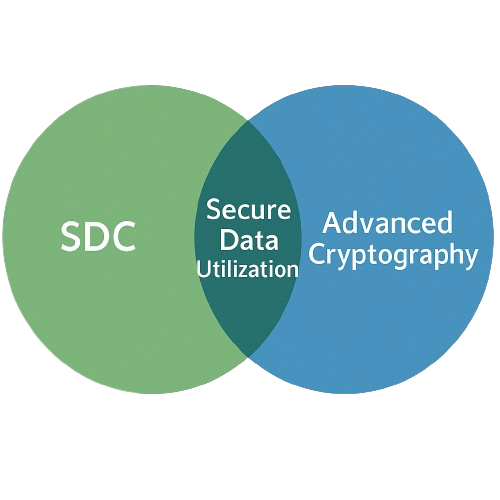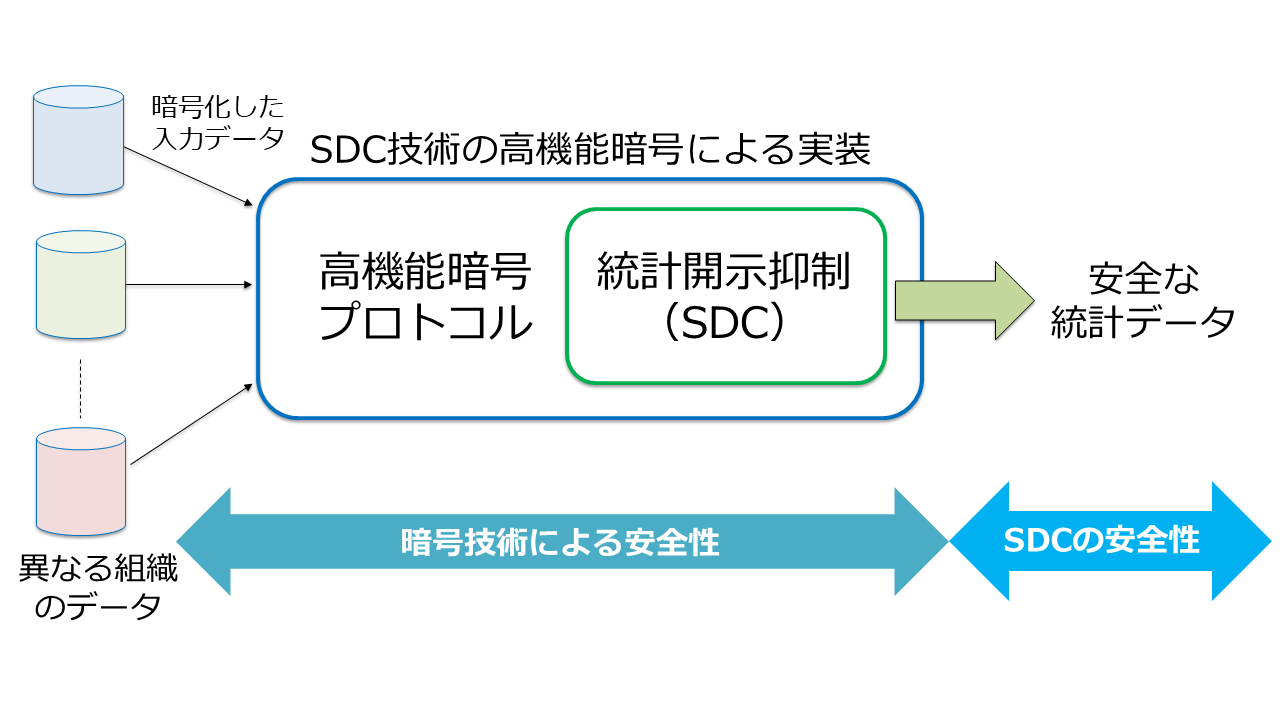Overview
Research and Development Initiative: Encryption-related Technologies Supporting Secure Data Distribution (Advanced Cryptographic Technologies) *
Integration of Large-Scale Distributed Data through the Systematization and Efficient Implementation of SDC Technologies in Conjunction with Advanced Cryptography
Funded by Key and Advanced Technology R&D through Cross Community Collaboration Program of Japan Science and Technology Agency (JST)
* [Tentative Translation]

Project SDC4Society
We are shaping a future where the full potential of data can be realized while safeguarding privacy.
By integrating advanced cryptographic technologies that enable analysis on encrypted data with statistical disclosure control (SDC) techniques that protect the privacy of analytical results, we are building a new data distribution infrastructure that ensures both utility and security.
Note:
Statistical Disclosure Control (SDC) is a privacy protection technique designed to prevent the inference of sensitive information about individuals or organizations from statistical data and analysis results.
To ensure confidentiality while preserving the utility of the data for academic research and business applications, techniques such as data masking and noise addition are applied prior to publication.
Secure, seamless, and smart —
building a data lifecycle powered by cryptography and SDC.
building a data lifecycle powered by cryptography and SDC.

At Project SDC4Society, we are working to build a secure data circulation society in which every stage of the data lifecycle—from generation and transmission to storage and analysis—is reliably protected.
By ensuring trust and privacy throughout the entire flow of data in the cyber society, we aim to create a future where data utilization is both safe and effective.

Accelerating Secure Data Utilization through Collaboration among Four Research Groups and Society
In today’s world, our lives and industries are deeply intertwined with data at every level.
While the use of data is accelerating to address social issues and create new value, concerns over privacy violations and information leaks are becoming increasingly serious.
Project SDC4Society addresses the challenges of today’s cyber society by aiming to safeguard data throughout its entire lifecycle—from generation and transmission to storage and analysis. By creating an environment where data can be used with confidence, we seek to empower individuals, organizations, and society as a whole to make better use of data. Our ultimate goal is to foster the development of a trustworthy and secure data-driven society.
As part of this project, we are pursuing the following areas of research and development:
Systematization of Privacy Protection Techniques
We are systematizing privacy protection methodologies in the field of Statistical Disclosure Control (SDC) from both theoretical and practical perspectives, with the goal of developing concrete guidelines for applying appropriate combinations of SDC and advanced cryptographic technologies to address users’ privacy needs.Development and Evaluation of Large-Scale Data Integration Techniques
We are working to establish robust methodologies for the linkage of public large-scale datasets. In doing so, we are also exploring legal frameworks and evaluating technical safeguards to ensure the safe and effective use of linked data.Efficient Implementation of SDC on Encrypted Data
By applying SDC techniques directly to encrypted data using advanced cryptographic methods, we aim to achieve a balance between strong security and practical usability in data processing.Implementation and Application of Differential Privacy
Our goal is to establish techniques that allow sensitive information held by different organizations to be securely combined, enabling the safe extraction of socially meaningful trends and patterns from large datasets.Legal and Ethical Framework Development
In addition to ensuring technical safety, we are exploring legal and ethical dimensions to build sustainable rules for responsible and trustworthy data utilization.
Through these initiatives, Project SDC4Society aims to build an environment where data can be used safely and confidently across all sectors—healthcare, welfare, education, government, business, and beyond.
By integrating technology, policy, and ethics, we strive to design a secure and inclusive data ecosystem for the future of the information society.
Research Groups

Real-World Implementation of Privacy-Preserving Data Technologies — Collaboration Across Four Research Groups in SDC4Society
Project SDC4Society is dedicated to building a society where data can be used safely and confidently, supported by strong privacy protections. At the heart of our efforts is real-world implementation—not only developing technologies, but also embedding them into the systems and practices of everyday life.Real-world implementation goes beyond completing technical development. It requires aligning new technologies with legal frameworks, operational practices, ethical standards, and real-world workflows to ensure they function effectively within society.To this end, four research groups are working in close collaboration—moving beyond theory and technical innovation to include policy design, field testing, and engagement with social stakeholders. We are also partnering with businesses, government agencies, and related organizations to create environments where these technologies can be applied in practice, while taking real-world needs and constraints into account.Through this multidisciplinary collaboration and ongoing dialogue with society, Project SDC4Society is working to implement a trusted, privacy-conscious framework for secure data circulation in the real world.
[Group1]
SDC Fundamental Research Group
Research Organization of Information and Systems
The systematization of various SDC technologies and the formulation of practical guidelines for privacy protection
We evaluate and systematize the security and utility of various SDC technologies from both theoretical and empirical perspectives, and provide practical guidelines for selecting appropriate privacy protection techniques based on the implementation of SDC methods using advanced cryptographic protocols.
[Group2]
Applied Advanced Cryptographic Protocols Research Group
Gunma University
Research on efficient data processing with SDC keeping the data encrypted
Our research and development will focus on efficient methods of processing, distributing and linking data, analysing it, and applying SDC — all while keeping the data fully encrypted. We will develop and publish a library that uses FHE (Fully Homomorphic Encryption) to perform representative analyses and SDC methods.
[Group3]
Data Integration and Engineering Research Group
Chuo University
Developing Methodologies for Linking Official Large-Scale Data and Empirical Assessment of Privacy Preservation and Data Utility for Linked Data
We will not only investigate the availability of linked official large-scale data, but also establish a method for evaluating the safety of linked large-scale data by considering legal and technical measures to enable its safe utilization.
[Group4]
Scalable Differential Privacy Research Group
Kyoto Tachibana University
Research on Practical and Scalable Differential Privacy
for Large-Scale and High-Dimensional Data
This project will establish a practical and scalable framework for applying differential privacy to complex, real-world datasets, such as large-scale and high-dimensional geospatial data.
Achievements
Project SDC4Society combines Statistical Disclosure Control (SDC) with advanced cryptographic technologies to provide comprehensive protection across the entire data lifecycle—from generation and transmission to storage and analysis.
Our mission is to create a secure and trustworthy data ecosystem where data flows safely and responsibly throughout society.
Through symposiums and outreach activities, we actively share cutting-edge research outcomes with the broader public, aiming to promote understanding and unlock the full potential of these innovations.
